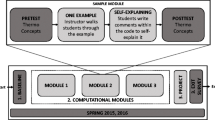Abstract
Introductory thermodynamics is a topic which is covered in a wide variety of science and engineering educations. However, very different teaching traditions have evolved within different scientific specialties. In this study we examine three courses in introductory thermodynamics within three different scientific specialties: physics, chemical engineering and mechanical engineering. Based on a generalization of Kuhn’s theory of disciplinary matrix, and the idea of boundary objects we analyse how basic thermodynamics theory is conceived in the different scientific specialties. The study is based on interviews with teachers and analysis of the different textbook traditions. It is concluded that teachers need to take into account how subject matter is conceived in other related scientific specialties when designing courses. Two examples demonstrating how this may be done are given.

Similar content being viewed by others
Notes
Our translation of the Danish text.
The terminology of control mass/volume is standard in mechanical engineering, and is of German origin. Vincenti points out, that the German word ‘Kontroll’ means ‘auditing’ (as in bookkeeping) as well as ‘regulation’, and it is the former meaning in particular which is aimed at with the term (Vincenti 1990, p. 284, n. 2).
Vincenti has given a thorough description of the principles and history of the methodology (Vincenti 1990, Chapter 4).
A good discussion of this can be found in Bucciarelli (1996).
References
Atkins, P. W. (1994). Physical chemistry (4th ed.). Oxford, UK: Oxford University Press.
Baierlein, R. (1999). Thermal physics. Cambridge, UK: Press Syndicate of the University of Cambridge.
Biggs, J. (1999). Teaching for quality learning at university. Buckingham, UK: Society for Reaserch into Higher Education.
Both, E., & Christiansen, G. (2002). Termodynamik (4th ed.). Lyngby, Denmark: Den private Ingeniørfond.
Bucciarelli, L. L. (1996). Designing engineers. Cambridge, MA: The MIT Press.
Bucciarelli, L. L. (2003). Designing and learning: A disjunction in contexts. Design Studies, 24(3), 295–311.
Callen, H. B. (1985). Thermodynamics and an introduction to thermostatistics (2nd ed.). New York, NY: Wiley (Revised edition of: Thermodynamics, 1960).
Chevellard, Y. (1985). La transposition didactique. Du savoir savant au savoir enseigné (The didactical transposition. From scientific knowledge to taught knowledge). Grenoble, France: La Pensée Sauvage.
Feynman, R. (1967). The character of physical law. Cambridge, MA: The MIT Press.
Guggenheim, E. A. (1967). Thermodynamics – an advanced treatment for chemists and physicists (5th revised ed.). Amsterdam, The Netherlands: North-Holland. (First edition 1949).
Hendricks, V., Jakobsen, A., & Pedersen, S. (2000). Identification of matrices in science and engineering. Journal for General Philosophy of Science, 31, 277–305.
Jones, J. B., & Dugan, R. E. (1996). Engineering thermodynamics. Englewood Cliffs, NJ: Prentice-Hall.
Keenan, J. H. (1941). Thermodynamics. New York: Wiley.
Knorr Cetina, K. (1999). Epistemic cultures. Cambridge, MA: Harvard University Press.
Kuhn, T. S. (1970). The structure of scientific revolutions (2nd ed.). Chicago: University of Chicago.
Laidler, K., Meiser, J. H., & Sanctuary, B. C. (2003). Physical chemistry (4th ed.). Boston: Houghton Mifflin.
Latour, B. (1988). Science in action. Cambridge, MA: Harvard University Press.
Levine, I. N. (1995). Physical chemistry. New York: McGraw-Hill.
Loverude, M. E., Kautz, C. H., & Heron, P. R. L. (2002). Student understanding of the first law of thermodynamics: Relating work to the adiabatic compression of an ideal gas. American Journal of Physics, 70(2), 137–148.
McDermott, L. C., & Redish, E. F. (1999). Resource letter: Per–1: Physics education research. American Journal of Physics, 67, 755–767.
Mooney, D. A. (1953). Mechanical engineering thermodynamics. New York: Prentice-Hall.
Moore, W. J. (1972). Physical chemistry (5th ed.). London: Longman House. (First edition published 1950).
Moran, M. J., & Shapiro, H. N. (1998). Fundamentals of engineering thermodynamics (3rd ed.). London: Wiley.
Ohanian, H. C. (1985). Physics (2nd expanded ed.). New York, NY: W. W. Norton.
Prosser, M., & Trigwell, K. (1999). Understanding learning and teaching. The experience in higher education. Buckingham, UK: Society for Reaserch into Higher Education.
Reynolds, W. C. (1968). Thermodynamics (2nd ed.). New York: McGraw-Hill.
Reynolds, W. C., & Perkins, H. C. (1977). Engineering thermodynamics (2nd ed.). New York: McGraw-Hill Science/Engineering/Math.
Royer, J. M., Mestre, J. P., & Defresne, R. J. (2005). Introduction: Framing the transfer problem. In J. P. Mestre (Ed.), Transfer of leaning from a modern multidisciplinary perspective (pp. vii–xxvi). Greenwich, CT: Information Age Publishing.
Rump, C., Jakobsen, A., & Clemmensen, T. (1998). Improving conceptual understanding and using qualitative tests. In C. Rust (Ed.), 6 improving student learning outcomes (pp. 298–308). Oxford, UK: Oxford Centre for Staff & Learning Development.
Shapiro, A. H. (1953). The dynamics and thermodynamics of compressible fluid flow (Vol. 1). New York: Ronald Press.
Star, S. L., & Griesemer, J. R. (1989). Institutional ecology, ‘translations’ and boundary objects: Amateurs and professionals in Berkeley’s Museum of Vertebrate Zoology, 1907–37. Social Studies of Science, 19(3), 387–420 (August).
Vincenti, W. (1990). What engineers know and how they know it. Baltimore, MD: Johns Hopkins University Press.
Young, H. D., & Freedman, R. A. (2003). Sears and Zemansky’s university physics with modern physics (11th ed.). San Francisco, CA (First edition by Sears and Zemansky, 1949).
Zemansky, M. W. (1957). Heat and thermodynamics – an intermediate textbook for students of physics, chemistry and engineering (4th ed.). New York: McGraw-Hill (First edition 1937).
Author information
Authors and Affiliations
Corresponding author
Rights and permissions
About this article
Cite this article
Christiansen, F.V., Rump, C. Three Conceptions of Thermodynamics: Technical Matrices in Science and Engineering. Res Sci Educ 38, 545–564 (2008). https://doi.org/10.1007/s11165-007-9061-x
Received:
Accepted:
Published:
Issue Date:
DOI: https://doi.org/10.1007/s11165-007-9061-x




